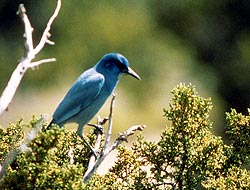Pinyon Jay (Gymnorhinus cyanocephalus) - Wiki Pinyon Jay
From Wikipedia, the free encyclopedia
Order: Passeriformes
Family: Corvidae
[Photo] Pinyon Jay (Gymnorhinus cyanocephalus). US NPS photo. Source: http://www.nps.gov/brca/pinyon_pine.html
The Pinyon Jay (Gymnorhinus cyanocephalus) is a jay between the North American Blue Jay and the Eurasian Jay in size. It is the only member of the genus Gymnorhinus. Its overall proportions are very Nutcracker-like and indeed this can be seen as convergent evolution as both birds fill similar ecological niches. The pinyon jay is a bluish-grey coloured bird with deeper head colouring and whitish throat with black bill, legs and feet.
This species occurs in western North America from central Oregon to northern Baja California and east as far as western Oklahoma though it wanders further afield out of the breeding season. It lives in foothills where the pinyon pines Pinus edulis and Pinus monophylla occur.
This species is highly social, often forming very large flocks of 250 or more birds, and several birds always seem to act as sentries for the flock, watching out for predators while their companions are feeding. The seed of the Pinyon pine is the staple food but they supplement their diet with fruits and berries. Insects of many types are also eaten and sometimes caught with its feet.
The nest is always part of a colony but there is never more than one nest in a tree. Sometimes the colony can cover quite extensive areas with a single nest in each tree (usually juniper, live oak or pine). There are usually 3-4 eggs laid, quite early in the season. Incubation is usually 16 days. The male bird normally brings food near to the nest, and the female flies to him to receive it and take back to the nest to feed the chicks that fledge around 3 weeks later. The pair normally only feed their own young, but once they reach near-fledging size they can sometimes receive a meal from any passing member of the colony, which can continue for some time after leaving the nest.
The Pinyon Jay was first collected, recorded and described as a species from a specimen shot along the Maria River in Northern Montana during the Prince Maximilian of Wied-Neuwied, Expedition to the Interior of North America in 1833.
The voice is described as a rhythmic krawk-kraw-krawk repeated two or three times.
http://en.wikipedia.org/wiki/Pinyon_Jay
| The text in this page is based on the copyrighted Wikipedia article shown in above URL. It is used under the GNU Free Documentation License. You may redistribute it, verbatim or modified, providing that you comply with the terms of the GFDL. |
